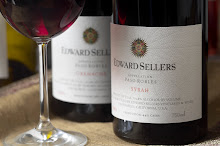May 11, 2012
Our estate vineyard is brimming with life. The plants are fully awake, the ladybugs are ganging up on delicious (to them) aphids, and, if you listen closely enough, you can just about hear the shoots growing.
Our Grenache vines are the most advanced so far, with shoots about 6 inches long. The Roussanne is lagging, with shoots between one-half inch and 2 inches. The trend will likely continue past fruit set, but we will undoubtedly harvest Roussanne before Grenache.
As noted in a previous post, we’ve begun some important changes here at Edward Sellers. We have purposely cut back on the available fruiting positions on the vines to redirect some of the energy back into the wood and, further down the road, the potential grapes. Come harvest, the vines will yield no more than about 2 tons of fruit per acre. In doing so this year we hope to enliven the vines and make the fruit that we do harvest that much more concentrated.
With all the desirable growth we must also contend with springtime’s unwanted visitor: powdery mildew. Mildew is present in every vineyard worldwide and loves the kinds of temperatures that grapes and humans also like: 70 degrees to 90 degrees Fahrenheit. Left unchecked, powdery mildew will destroy a season’s crop.
To combat powdery mildew we spray a mixture of organic horticultural oil and a dilute tea that we make from the plant Equisetum arvense, commonly known as horsetail. We follow the UC Davis Powdery Mildew Index to determine when and how often to spray. Generally, we will do so every 12 to 14 days until the fruit reaches about 13 brix.
Next week we will begin thinning shoots and removing suckers. This cultural practice will allow the vines to focus on growing the fruit that we want and it will open them up to the sun and the wind.
Tuesday, May 15, 2012
Vineyard Update - May 11th
Posted by
Ed Sellers
at
4:39 PM
0
comments
![]()
Thursday, May 10, 2012
Going Biodynamic!
 The 2012 growing season has just begun here at Edward Sellers and along with the change of seasons we are taking a new approach to growing our grapes. We are now farming our estate biodynamically, with an eye toward enlivening not just our grapevines but also our olive trees and our soils in general. We hope this approach will lead to even more interesting wines and a healthier environment for all the animals (those that drink wine and those that don’t) that visit our estate.
The 2012 growing season has just begun here at Edward Sellers and along with the change of seasons we are taking a new approach to growing our grapes. We are now farming our estate biodynamically, with an eye toward enlivening not just our grapevines but also our olive trees and our soils in general. We hope this approach will lead to even more interesting wines and a healthier environment for all the animals (those that drink wine and those that don’t) that visit our estate.
Austrian farmer and philosopher Rudolph Steiner developed the Biodynamic farming method in the 1920s as a holistic way to grow crops, and he did so with the understanding that farming is not just about rainfall, micronutrients and heat. There are spiritual forces at work, too. The Biodynamic method of farming incorporates the rhythm of the earth and the movements of the planets, enfolding these seemingly disparate systems into a whole. Think of your own circadian rhythms, or the effect of the moon on the tides, and you’ll get an idea where the biodynamics is coming from.
In practical terms, that means, among other things, rejuvenating the soil by applying concentrated amounts of cow manure to the ground after we have stirred this mixture by hand for an hour. And when we prune now, we do so according to the position of the moon and the planets.
We don’t expect to see results immediately. We may not, in fact, see any measurable results for several years. That’s okay. We are farming this estate for the future and making wines that can be enjoyed for years to come.
Jeremy Weintraub
Winemaker
Posted by
Ed Sellers
at
3:43 PM
1 comments
![]()


